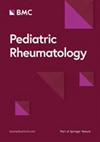长非编码 RNA(CTC-471J1.2、NeST)作为活动性幼年狼疮肾炎的表观遗传风险因素:一项病例对照研究
IF 2.8
3区 医学
Q1 PEDIATRICS
引用次数: 0
摘要
对狼疮性肾炎(LN)患者体内循环中长非编码 RNA(lncRNA)水平的测量,可以大大提高对疾病发病机制的认识。因此,我们的目的是量化狼疮性肾炎患者体内 CTC-471J1.2 和 NeST 的表达水平,并将其与疾病活动相关联。这项病例对照研究的对象是在曼苏拉大学儿童医院(MUCH)就诊的一组幼年 LN 患儿。除了通过定量实时 PCR 检测 lncRNA 外,还收集了人口统计学、临床和实验室检查结果。与非活动性病例或对照组相比,活动性LN患儿的lncRNAs-CTC-471J1.2表达水平明显下调。相比之下,NeST在活动性LN病例中则明显上调。研究发现,CTC-471J1.2的表达与LN活动参数之间存在明显的相关性。此外,这两个lncRNA在活动性LN的分化中显示出合理的敏感性和特异性。回归分析模型显示,CTC-471J1.2和NeST是活动性肾炎的独立预测因子。循环lncRNA-CTC-471J1.2和NeST的表达水平可作为活动性LN的敏感性和特异性生物标志物。此外,二者还可作为肾炎活动性的预测因子。本文章由计算机程序翻译,如有差异,请以英文原文为准。
Long noncoding RNAs (CTC-471J1.2, NeST) as epigenetic risk factors of active juvenile lupus nephritis: a case-control study
Measurement of the circulating levels of long-non-coding RNAs (lncRNAs) in lupus nephritis (LN) patients could dramatically explore more insights about the disease pathogenesis. Hence, we aimed to quantify the level of expression of CTC-471J1.2 and NeST in LN patients and to correlate it with the disease activity. This case-control study was conducted on a group of children with juvenile LN attending to Mansoura University Children’s Hospital (MUCH). Demographics, clinical, and laboratory findings were collected besides the measurement of lncRNAs by quantitative real-time PCR. The expression level of lncRNAs-CTC-471J1.2 was significantly down-regulated in children with active LN versus inactive cases or controls. In contrast, the NeST was significantly up-regulated in active LN cases. A significant correlation was found between CTC-471J1.2 expression and LN activity parameters. Additionally, both lncRNAs showed a reasonable sensitivity and specificity in differentiation of active LN. A regression analysis model revealed that CTC-471J1.2 and NeST were independent predictors of active nephritis. The expression level of circulatory lncRNAs-CTC-471J1.2 and NeST can be used as sensitive and specific biomarkers for active LN. Furthermore, both could serve as predictors for nephritis activity.
求助全文
通过发布文献求助,成功后即可免费获取论文全文。
去求助
来源期刊

Pediatric Rheumatology
PEDIATRICS-RHEUMATOLOGY
CiteScore
4.10
自引率
8.00%
发文量
95
审稿时长
>12 weeks
期刊介绍:
Pediatric Rheumatology is an open access, peer-reviewed, online journal encompassing all aspects of clinical and basic research related to pediatric rheumatology and allied subjects.
The journal’s scope of diseases and syndromes include musculoskeletal pain syndromes, rheumatic fever and post-streptococcal syndromes, juvenile idiopathic arthritis, systemic lupus erythematosus, juvenile dermatomyositis, local and systemic scleroderma, Kawasaki disease, Henoch-Schonlein purpura and other vasculitides, sarcoidosis, inherited musculoskeletal syndromes, autoinflammatory syndromes, and others.
 求助内容:
求助内容: 应助结果提醒方式:
应助结果提醒方式:


